Page 595 of 788
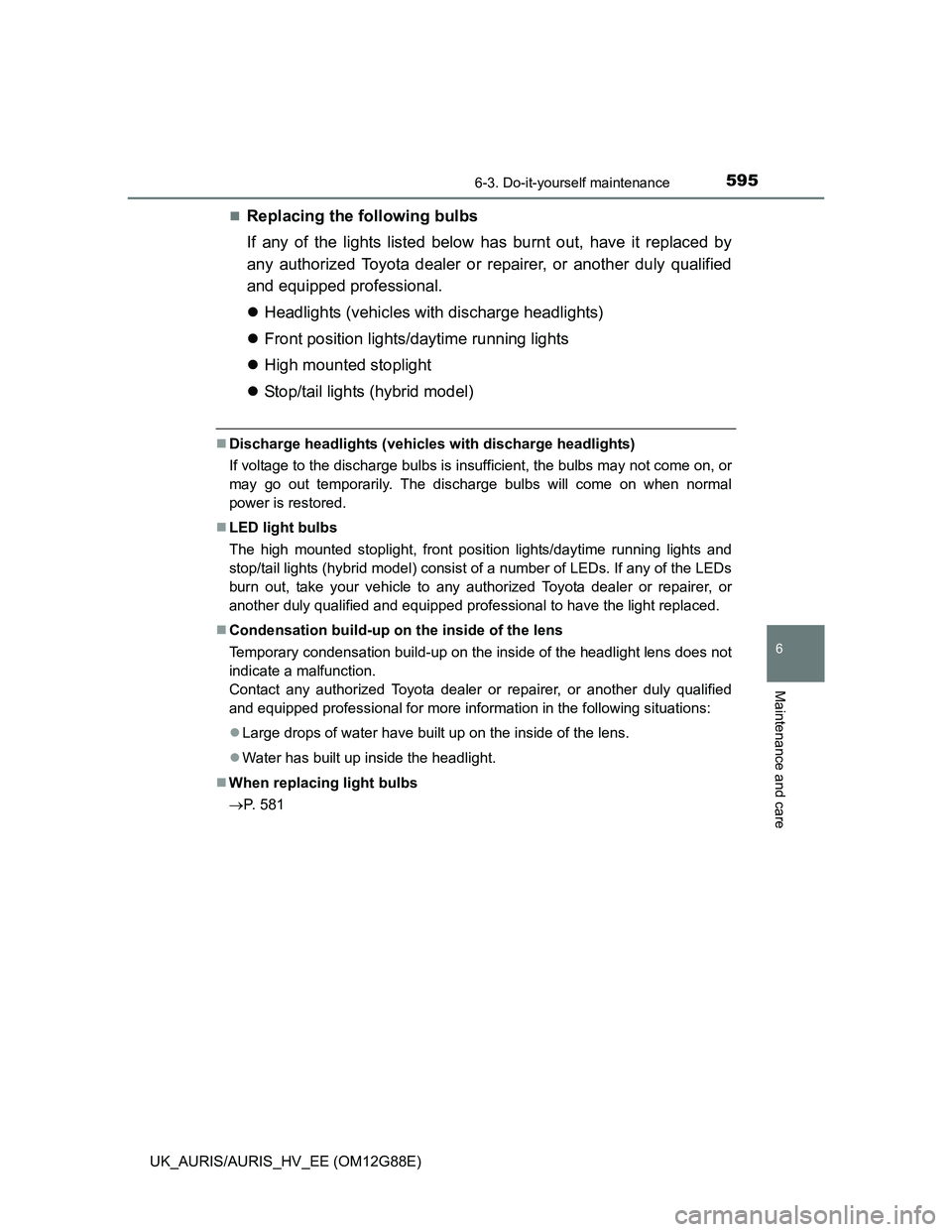
5956-3. Do-it-yourself maintenance
UK_AURIS/AURIS_HV_EE (OM12G88E)
6
Maintenance and care
Replacing the following bulbs
If any of the lights listed below has burnt out, have it replaced by
any authorized Toyota dealer or repairer, or another duly qualified
and equipped professional.
Headlights (vehicles with discharge headlights)
Front position lights/daytime running lights
High mounted stoplight
Stop/tail lights (hybrid model)
Discharge headlights (vehicles with discharge headlights)
If voltage to the discharge bulbs is insufficient, the bulbs may not come on, or
may go out temporarily. The discharge bulbs will come on when normal
power is restored.
LED light bulbs
The high mounted stoplight, front position lights/daytime running lights and
stop/tail lights (hybrid model) consist of a number of LEDs. If any of the LEDs
burn out, take your vehicle to any authorized Toyota dealer or repairer, or
another duly qualified and equipped professional to have the light replaced.
Condensation build-up on the inside of the lens
Temporary condensation build-up on the inside of the headlight lens does not
indicate a malfunction.
Contact any authorized Toyota dealer or repairer, or another duly qualified
and equipped professional for more information in the following situations:
Large drops of water have built up on the inside of the lens.
Water has built up inside the headlight.
When replacing light bulbs
P. 581
Page 596 of 788
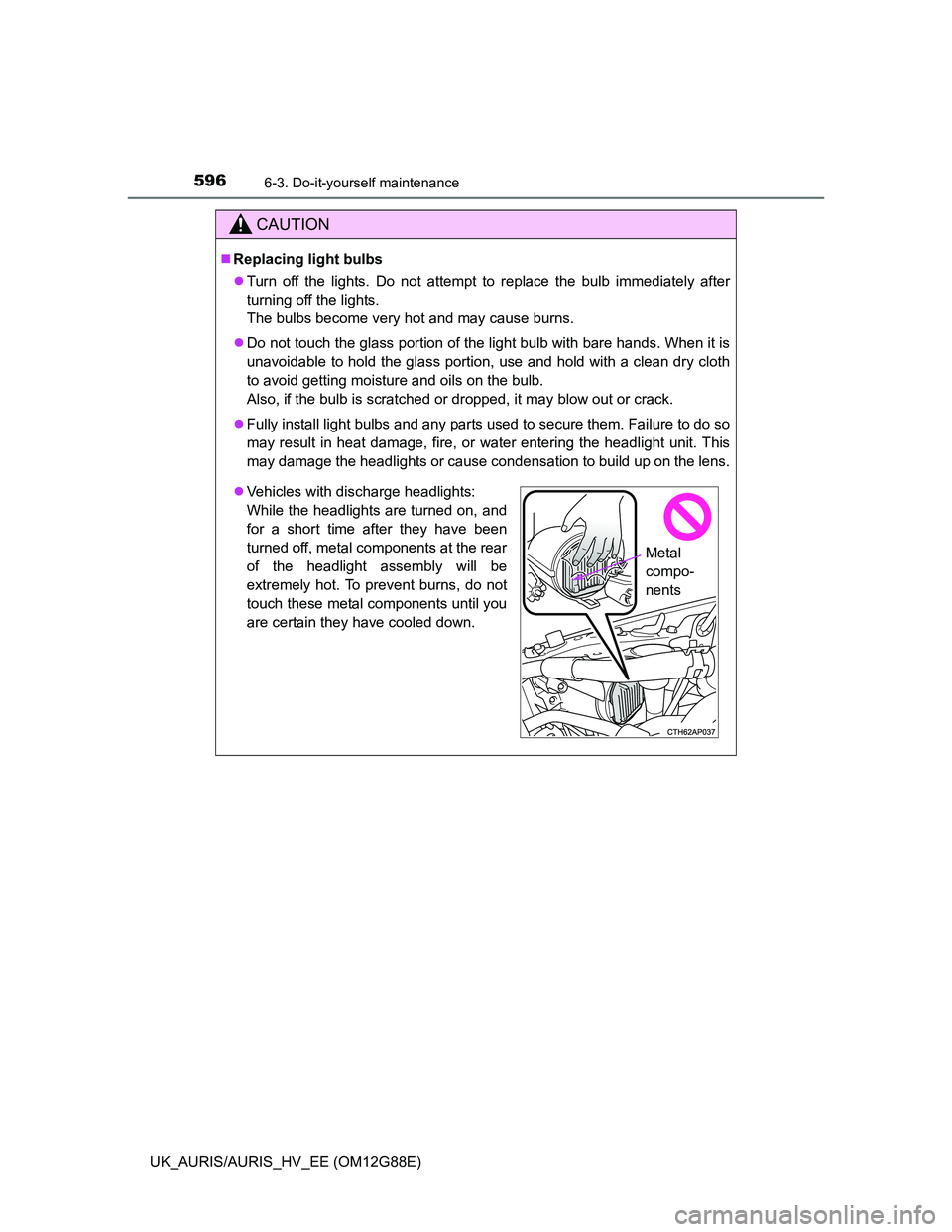
5966-3. Do-it-yourself maintenance
UK_AURIS/AURIS_HV_EE (OM12G88E)
CAUTION
Replacing light bulbs
Turn off the lights. Do not attempt to replace the bulb immediately after
turning off the lights.
The bulbs become very hot and may cause burns.
Do not touch the glass portion of the light bulb with bare hands. When it is
unavoidable to hold the glass portion, use and hold with a clean dry cloth
to avoid getting moisture and oils on the bulb.
Also, if the bulb is scratched or dropped, it may blow out or crack.
Fully install light bulbs and any parts used to secure them. Failure to do so
may result in heat damage, fire, or water entering the headlight unit. This
may damage the headlights or cause condensation to build up on the lens.
Vehicles with discharge headlights:
While the headlights are turned on, and
for a short time after they have been
turned off, metal components at the rear
of the headlight assembly will be
extremely hot. To prevent burns, do not
touch these metal components until you
are certain they have cooled down.
Metal
compo-
nents
Page 597 of 788
5976-3. Do-it-yourself maintenance
UK_AURIS/AURIS_HV_EE (OM12G88E)
6
Maintenance and care
CAUTION
Discharge headlights (vehicles with discharge headlights)
Contact any authorized Toyota dealer or repairer, or another duly qualified
and equipped professional, before replacing the discharge headlights
(including light bulbs).
Do not touch the discharge headlight’s high voltage socket when the head-
lights are turned on.
An extremely high voltage of 30000 V will be discharged and could result
in death or serious injury by electric shock.
Do not attempt to take apart or repair the headlight bulbs, connectors,
power supply circuits, or related components.
Doing so could result in electric shock and death or serious injury.
To prevent damage or fire
Make sure bulbs are fully seated and locked.
Page 700 of 788
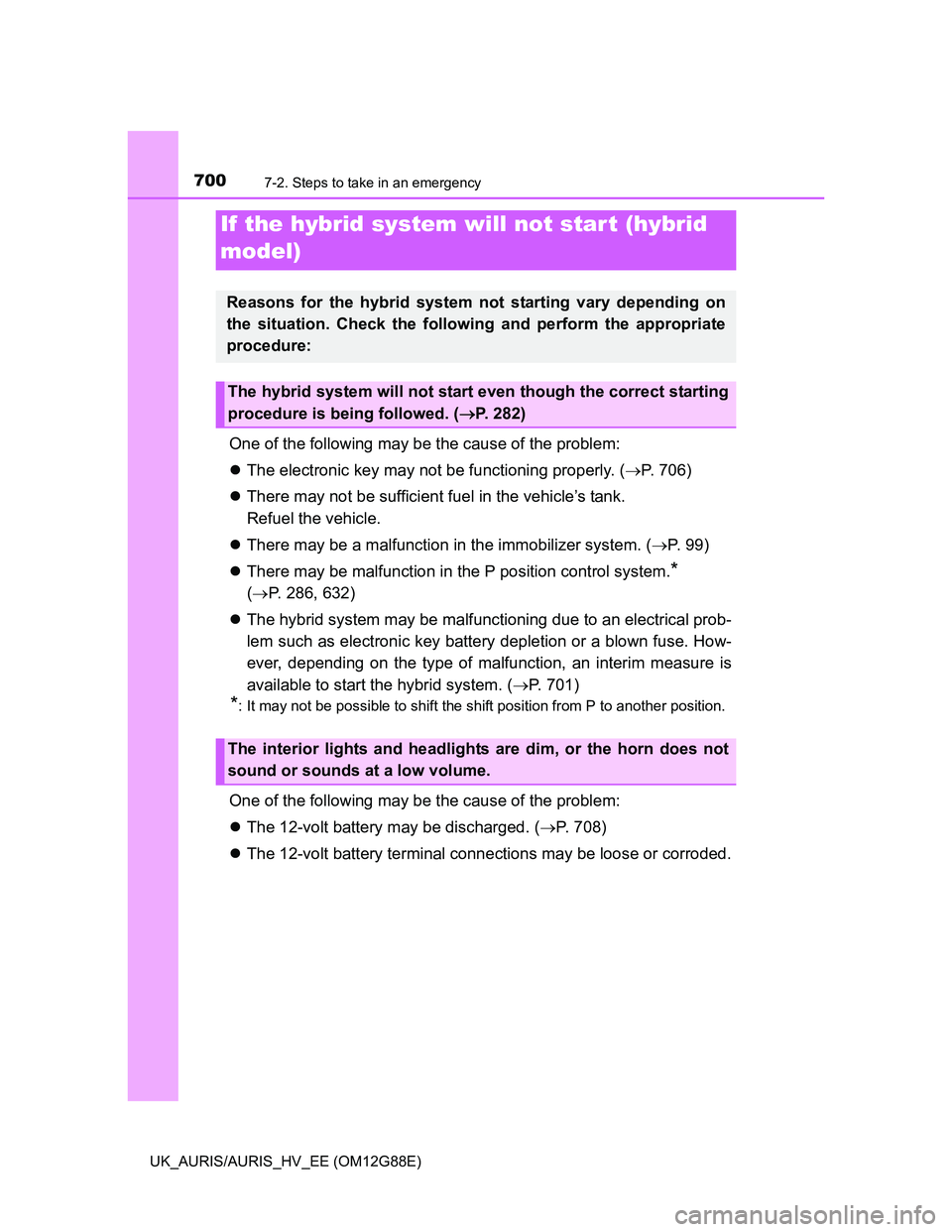
7007-2. Steps to take in an emergency
UK_AURIS/AURIS_HV_EE (OM12G88E)
One of the following may be the cause of the problem:
The electronic key may not be functioning properly. (P. 706)
There may not be sufficient fuel in the vehicle’s tank.
Refuel the vehicle.
There may be a malfunction in the immobilizer system. (P. 9 9 )
There may be malfunction in the P position control system.
*
(P. 286, 632)
The hybrid system may be malfunctioning due to an electrical prob-
lem such as electronic key battery depletion or a blown fuse. How-
ever, depending on the type of malfunction, an interim measure is
available to start the hybrid system. (P. 701)
*: It may not be possible to shift the shift position from P to another position.
One of the following may be the cause of the problem:
The 12-volt battery may be discharged. (P. 708)
The 12-volt battery terminal connections may be loose or corroded.
If the hybrid system will not star t (hybrid
model)
Reasons for the hybrid system not starting vary depending on
the situation. Check the following and perform the appropriate
procedure:
The hybrid system will not start even though the correct starting
procedure is being followed. (P. 282)
The interior lights and headlights are dim, or the horn does not
sound or sounds at a low volume.
Page 701 of 788
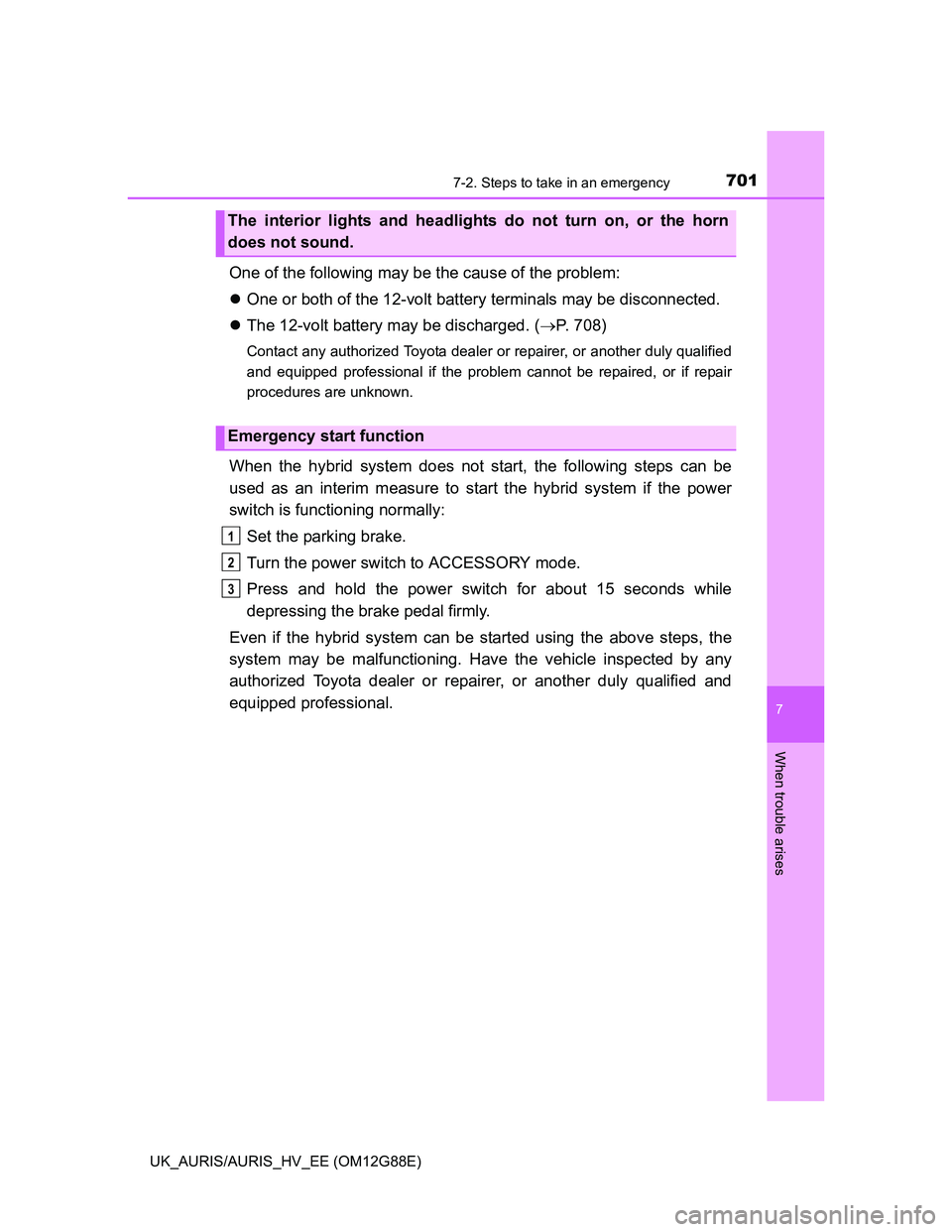
7017-2. Steps to take in an emergency
UK_AURIS/AURIS_HV_EE (OM12G88E)
7
When trouble arises
One of the following may be the cause of the problem:
One or both of the 12-volt battery terminals may be disconnected.
The 12-volt battery may be discharged. (P. 708)
Contact any authorized Toyota dealer or repairer, or another duly qualified
and equipped professional if the problem cannot be repaired, or if repair
procedures are unknown.
When the hybrid system does not start, the following steps can be
used as an interim measure to start the hybrid system if the power
switch is functioning normally:
Set the parking brake.
Turn the power switch to ACCESSORY mode.
Press and hold the power switch for about 15 seconds while
depressing the brake pedal firmly.
Even if the hybrid system can be started using the above steps, the
system may be malfunctioning. Have the vehicle inspected by any
authorized Toyota dealer or repairer, or another duly qualified and
equipped professional.
The interior lights and headlights do not turn on, or the horn
does not sound.
Emergency start function
1
2
3
Page 712 of 788
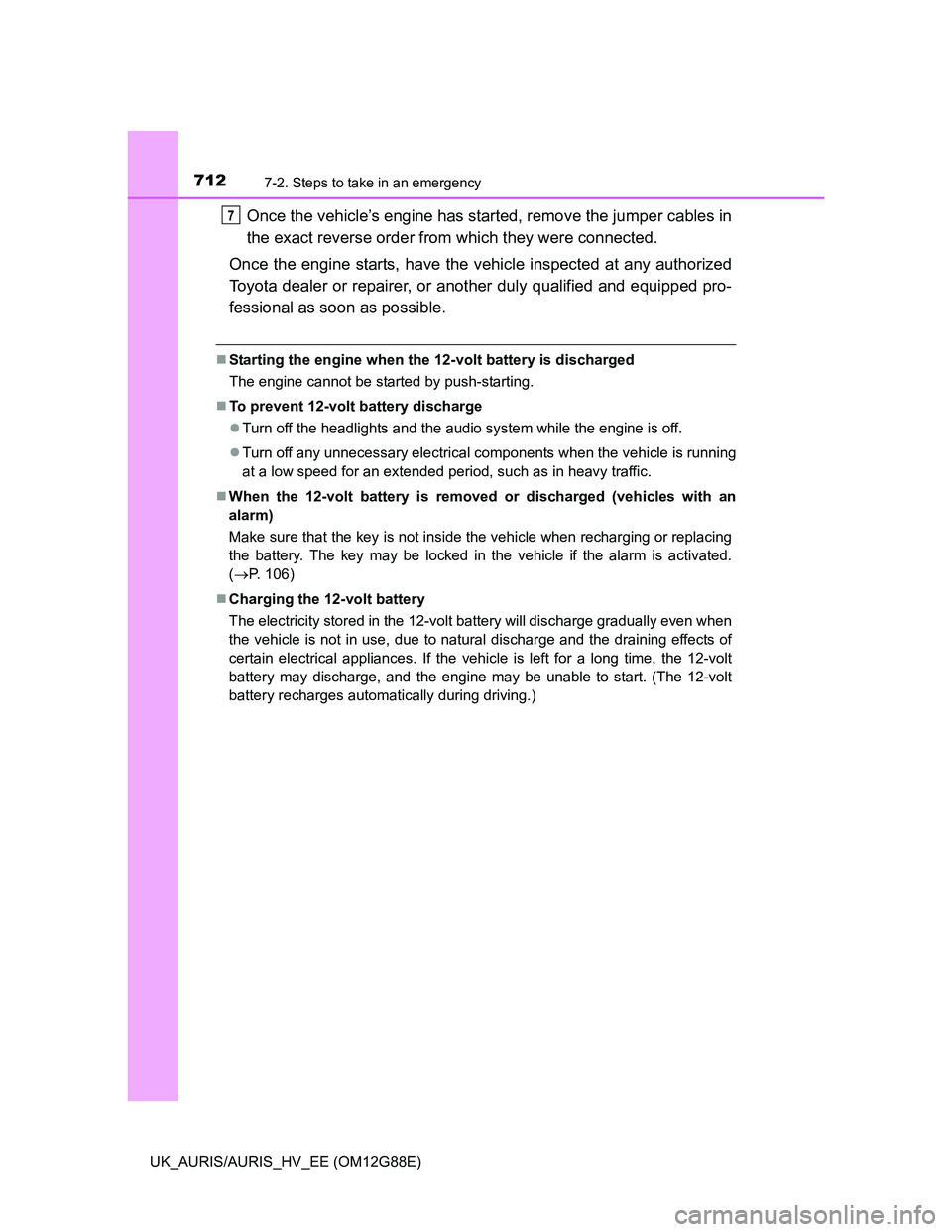
7127-2. Steps to take in an emergency
UK_AURIS/AURIS_HV_EE (OM12G88E)
Once the vehicle’s engine has started, remove the jumper cables in
the exact reverse order from which they were connected.
Once the engine starts, have the vehicle inspected at any authorized
Toyota dealer or repairer, or another duly qualified and equipped pro-
fessional as soon as possible.
Starting the engine when the 12-volt battery is discharged
The engine cannot be started by push-starting.
To prevent 12-volt battery discharge
Turn off the headlights and the audio system while the engine is off.
Turn off any unnecessary electrical components when the vehicle is running
at a low speed for an extended period, such as in heavy traffic.
When the 12-volt battery is removed or discharged (vehicles with an
alarm)
Make sure that the key is not inside the vehicle when recharging or replacing
the battery. The key may be locked in the vehicle if the alarm is activated.
(P. 106)
Charging the 12-volt battery
The electricity stored in the 12-volt battery will discharge gradually even when
the vehicle is not in use, due to natural discharge and the draining effects of
certain electrical appliances. If the vehicle is left for a long time, the 12-volt
battery may discharge, and the engine may be unable to start. (The 12-volt
battery recharges automatically during driving.)
7
Page 717 of 788
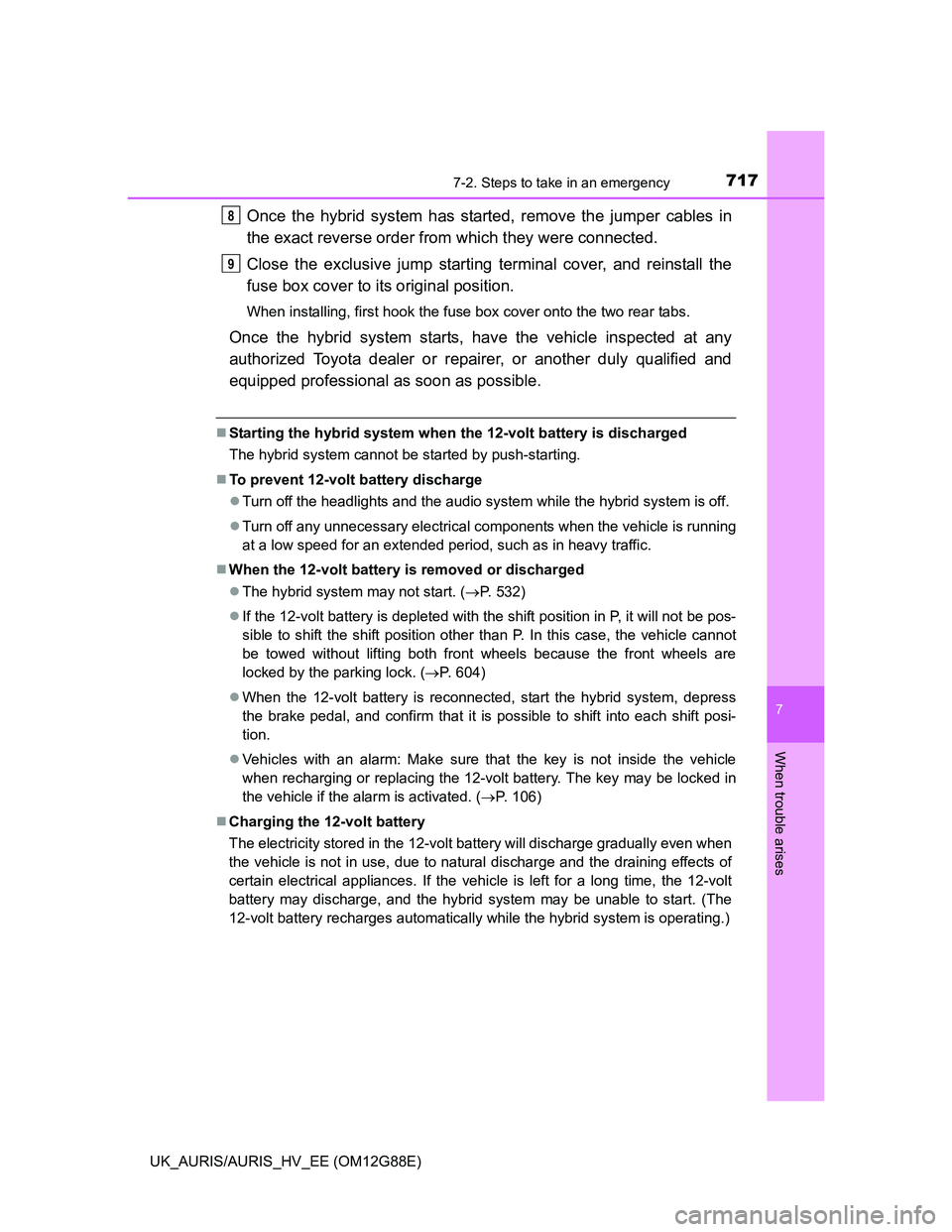
7177-2. Steps to take in an emergency
UK_AURIS/AURIS_HV_EE (OM12G88E)
7
When trouble arises
Once the hybrid system has started, remove the jumper cables in
the exact reverse order from which they were connected.
Close the exclusive jump starting terminal cover, and reinstall the
fuse box cover to its original position.
When installing, first hook the fuse box cover onto the two rear tabs.
Once the hybrid system starts, have the vehicle inspected at any
authorized Toyota dealer or repairer, or another duly qualified and
equipped professional as soon as possible.
Starting the hybrid system when the 12-volt battery is discharged
The hybrid system cannot be started by push-starting.
To prevent 12-volt battery discharge
Turn off the headlights and the audio system while the hybrid system is off.
Turn off any unnecessary electrical components when the vehicle is running
at a low speed for an extended period, such as in heavy traffic.
When the 12-volt battery is removed or discharged
The hybrid system may not start. (P. 532)
If the 12-volt battery is depleted with the shift position in P, it will not be pos-
sible to shift the shift position other than P. In this case, the vehicle cannot
be towed without lifting both front wheels because the front wheels are
locked by the parking lock. (P. 604)
When the 12-volt battery is reconnected, start the hybrid system, depress
the brake pedal, and confirm that it is possible to shift into each shift posi-
tion.
Vehicles with an alarm: Make sure that the key is not inside the vehicle
when recharging or replacing the 12-volt battery. The key may be locked in
the vehicle if the alarm is activated. (P. 106)
Charging the 12-volt battery
The electricity stored in the 12-volt battery will discharge gradually even when
the vehicle is not in use, due to natural discharge and the draining effects of
certain electrical appliances. If the vehicle is left for a long time, the 12-volt
battery may discharge, and the hybrid system may be unable to start. (The
12-volt battery recharges automatically while the hybrid system is operating.)
8
9
Page 754 of 788
7548-1. Specifications
UK_AURIS/AURIS_HV_EE (OM12G88E)
Light bulbs
Light BulbsWTy p e
Exterior
Headlights
Discharge bulbs
Halogen bulbs
35
55A
B
Front fog lights*119C
Front turn signal lights21D
Side turn signal lights5E
Rear fog light21F
Rear turn signal lights16F
Stop/tail lights*221/5G
Back-up lights16F
Licence plate lights5F
Interior
Vanity lights*15H
Front interior lights/personal lights8F
Rear interior light*18H
Rear personal lights*18F
Luggage compartment light5H
A: D4S discharge bulbs
C: H16 halogen bulbs
E: Wedge base bulbs (amber)
G: Single end bulbs (clear)
*1: If equipped
*2: Except hybrid modelB: HIR2 halogen bulbs
D: Single end bulbs (amber)
F: Wedge base bulbs (clear)
H: Double end bulbs